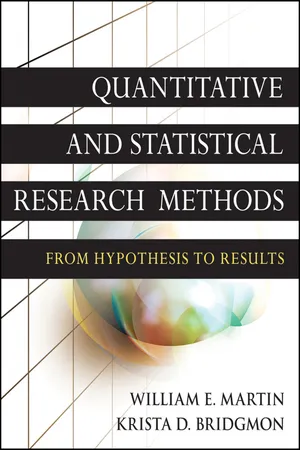
Quantitative and Statistical Research Methods
From Hypothesis to Results
- English
- ePUB (mobile friendly)
- Available on iOS & Android
Quantitative and Statistical Research Methods
From Hypothesis to Results
About this book
Quantitative and Statistical Research Methods
This user-friendly textbook teaches students to understand and apply procedural steps in completing quantitative studies. It explains statistics while progressing through the steps of the hypothesis-testing process from hypothesis to results. The research problems used in the book reflect statistical applications related to interesting and important topics. In addition, the book provides a Research Analysis and Interpretation Guide to help students analyze research articles.
Designed as a hands-on resource, each chapter covers a single research problem and offers directions for implementing the research method from start to finish. Readers will learn how to:
- Pinpoint research questions and hypotheses
- Identify, classify, and operationally define the study variables
- Choose appropriate research designs
- Conduct power analysis
- Select an appropriate statistic for the problem
- Use a data set
- Conduct data screening and analyses using SPSS
- Interpret the statistics
- Write the results related to the problem
Quantitative and Statistical Research Methods allows students to immediately, independently, and successfully apply quantitative methods to their own research projects.
Frequently asked questions
- Essential is ideal for learners and professionals who enjoy exploring a wide range of subjects. Access the Essential Library with 800,000+ trusted titles and best-sellers across business, personal growth, and the humanities. Includes unlimited reading time and Standard Read Aloud voice.
- Complete: Perfect for advanced learners and researchers needing full, unrestricted access. Unlock 1.4M+ books across hundreds of subjects, including academic and specialized titles. The Complete Plan also includes advanced features like Premium Read Aloud and Research Assistant.
Please note we cannot support devices running on iOS 13 and Android 7 or earlier. Learn more about using the app.
Information
Chapter 1
INTRODUCTION AND OVERVIEW
- Understand the purpose of the book and the structure of the book.
- Review independent, dependent, and extraneous variables and their scales of measurement.
- Review measures of central tendency and variability.
- Review visual representations of data, including the normal distribution.
- Review descriptive and inferential statistical applications of the normal distribution.
REVIEW OF FOUNDATIONAL RESEARCH CONCEPTS
Independent, Dependent, and Extraneous Variables
Table of contents
- Cover
- Contents
- Title
- Copyright
- Tables and Figures
- Preface
- The Authors
- Dedication
- Chapter 1: Introduction and Overview
- Chapter 2: Logical Steps of Conducting Quantitative Research
- Chapter 3: Maximizing Hypothesis Decisions Using Power Analysis
- Chapter 4: Research and Statistical Designs
- Chapter 5: Introduction to IBM SPSS 20
- Chapter 6: Diagnosing Study Data for Inaccuracies and Assumptions
- Chapter 7: Randomized Design Comparing Two Treatments and a Control Using a One-Way Analysis of Variance
- Chapter 8: Repeated-Treatment Design Using a Repeated-Measures Analysis of Variance
- Chapter 9: Randomized Factorial Experimental Design Using a Factorial ANOVA
- Chapter 10: Analysis of Covariance
- Chapter 11: Randomized Control Group and Repeated-Treatment Designs and Nonparametics
- Chapter 12: Bivariate and Multivariate Correlation Methods Using Multiple Regression Analysis
- Chapter 13: Understanding Quantitative Literature and Research
- References
- Index